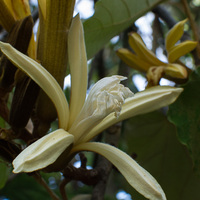Common name: Bayur Tree
Other common names: Dinner Plate Tree, Maple Leafed Bayur, Maple Twist
Description
Bayur or Dinner Plate Tree is a timber and landscape tree originating from India and Asia, its natural range extending from the Himalayan foothills, and hilly parts of central and eastern India, through Myanmar (Burma) to southern China.
It is a tree of variable size, growing to a medium-sized tree up to 24 m (80 ft) tall in the cooler parts of its range but is rarely above 15 m (50 ft) in warmer areas. Most trees develop a straight trunk supporting a rounded or irregularly-shaped crown of gently ascending branches. The bark is smooth, grey on young trees, becoming rough and darker with age.
The leaves are in the shape of a maple leaf, very large, dark glossy green on top and silvery underneath. In the wetter parts of its range, where the dry season is short, they remain on the tree throughout the year but fall elsewhere, with the tree left near leafless for a brief period.
The flowers are large, creamy-white, showy and sweetly fragrant, especially at night to attract bats, the tree's specialist pollinators. They bloom in spring but are short-lived, lasting only one night. However, their fragrance lingers on even after they have wilted and fallen to the ground.
The fertilised flowers are followed by cucumber-shaped seed capsules that persist on the tree for up to twelve months, turning brown as they mature. They contain numerous seed which are winged and designed for wind dispersal.
Use
Bayur is sometimes cultivated as an ornamental for its showy, sweetly fragrant flowers and its large leaves, which cast a deep shade, making it a popular shade tree in its native India. In the dry season, the downy, silvery under-surface of the leaves lighten, resulting in an eye-catching contrast of silver and green as they move in the wind.
The wood is medium-weight, in the 540 to 600 kg per cubic meter (34 to 37 lbs per cubic ft) range, with low natural resistance to decay, thus limiting its use outdoors. Its use is mainly confined to making plywood, packing boxes and crates, and safety matches and matchboxes.
The spent flowers are collected in its native range for use in clothing and linen cupboards as a deodoriser, adding a light fragrance to the clothes, sheets, and towels stored therein.
The large leaves are traditionally used as serving plates or platters and as wrapping material for wrapping small articles.
Climate
Grows naturally and has its best development in moderately humid to very humid subtropical and tropical climates, generally areas with annual lows of 10 to 21°C, annual highs of 20 to 33°C, annual rainfall of 1200 to 5500 mm and a dry season of 7 months or less.
Although also found in areas with annual rainfall of less than 1200 mm, the trees are usually close to a pond, swamp or watercourse, where the roots have water during dry periods.
Growing
New plants are mostly started from seed, which remain viable for up to twelve months under cool, dry storage.
It performs best on loam soils of a moderately acid to neutral nature, generally with a pH of 6.0 to 7.5 and on sites with full to partial sun exposure. It has good tolerance to seasonal flooding.
Problem features
There does not appear to be any records of escape and naturalisation anywhere, despite its introduction into areas outside of its native range. It is known to sprout root suckers, which can be a major gardening problem.
Where it grows
References
Books
-
Barwick, M., et al. 2004, Tropical & subtropical trees : a worldwide encyclopaedic guide, Thames and Hudson, London
-
Council of Scientific and Industrial Research (India) 1948 - 1976 (11 volumes), The Wealth of India : a dictionary of Indian raw materials and industrial products, Delhi
-
Dey, S.C. 1996, Fragrant flowers for homes and gardens, trade and industry, Abhinav Publications, New Delhi, India
-
Krishen, P. 2006, Trees of Delhi : a field guide, Dorling Kindersley Publishers, Delhi
-
Mathias, M. E., 1982, Flowering plants in the landscape, University of California Press, Berkeley
-
Menninger, E. A. 1962, Flowering trees of the world for tropics and warm climates, 1st ed., Heathside Press, New York
-
Randall, R. P. 2007, The introduced flora of Australia and its weed status, Cooperative Research Centre for Australian Weed Management, Glen Osmond, South Australia
-
Scheffer, T. C & Morrell, J. J. 1998, Natural durability of wood : a worldwide checklist of species, Forest Research Laboratory, Oregon State University, Corvallis, Oregon
-
Troup, R.S. & Joshi, H. B. 1975 to 1981, Silviculture of Indian Trees (3 volumes), Government of India Publications, New Delhi
Articles, Journals, Reports and Working Papers
-
S.Mohammad Yasin. 1994, Predicting the suitability of a wood species of known density for producing desired density particleboard.
-
Singh, K. P. & Kushwaha, C. P. 2006, Diversity of flowering and fruiting phenology of trees in a tropical deciduous forest in India, Oxford University Press




